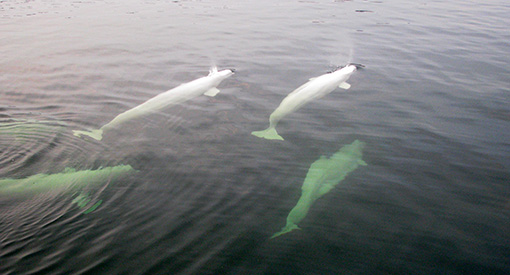
Marine wildlife
Wapusk National Park
Belugas
Wapusk National Park's coastlines are part of the Western Hudson Bay (WHB) beluga whale (Delphinapterus leucas) population's summering habitat. Beluga whales are Canada’s most abundant species of whale, and the WHB population is Canada’s largest, estimated at approximately 55,000 individuals. This population is considered to be stable and is listed as Not at Risk by the Committee on the Status of Endangered Wildlife in Canada.

The WHB beluga population seasonally migrates through the Hudson Strait to the same summering areas, which ranges from the Ontario border to just north of the Nunavut border. The belugas arrive from mid-June to early July, and begin their northward migration again in mid-September. The largest aggregations gather near the Churchill, Seal, and Nelson river estuaries, which serve as molting, feeding and nursery habitat. It is estimated that between 3,000 and 5,000 whales explore the Churchill River estuary every day during their peak!
Beluga whales are an essential part of Inuit communities and culture, and they remain interconnected with Inuit values, beliefs and harvesting practices. In fact, the WHB belugas are annually harvested by the Inuit people of Nunavut and Nunavik. Though the WHB beluga population is considered to be healthy and stable, as climate change continues to warm the planet, the number of threats they face is expected to increase. This population is expected to be exposed to increased vessel activity and marine noise, human developments (e.g. hydroelectric projects) and increased predation and harvest.
Interesting facts
- Adults range in total length from 2.6 to 4.5 metres (8.5 to 14.8 feet) and weigh up to 1,900 kilograms (4,189 lbs).
- Adult females are about approximately 80% of the length of males, and calves are approximately 48% of the length of their mothers.
- Females have calves every two to three years. Calves are grey, brown and blue at birth and lighten to white as they age.
- Beluga routinely swim around three to nine km/h; however, they can swim up to almost 30 km/h for short distances.
- As an arctic adaptation, the beluga’s body weight is between 40% and 50% fat. This forms a layer over the entire body, except for the head.
- Beluga whales have a varied diet consisting of crustaceans (such as crabs and shrimp), small fish (such as capelin, sand lance, arctic char and arctic cod), squid, molluscs (such as mussels and clams) and marine worms.
- Males reach sexual maturity around six to seven years of age, while females reach sexual maturity between the ages of four and seven. Mating takes place in the late winter and early spring, and gestation takes 13 to 14.5 months. Females usually have calves every two to three years.
- The average lifespan of a Western Hudson Bay beluga is estimated to be 50 years, but some researchers believe they can live up to 90.
- Beluga whales do not have many predators, but their main three include polar bears, orca whales and humans.
- Beluga whales are one of three species of cetaceans with a flexible neck (other two are narwhal and Irrawaddy dolphin).
- Beluga whales are one of five species known to undergo menopause (others four are humans, narwhals, orca whales and short-finned pilot whales).
Seals
Wapusk National Park includes the intertidal zone where the coast of the Hudson Bay meets the shore of the Hudson Bay Lowlands. This intertidal zone can extend a few kilometres from the true shore of Wapusk National Park and is an important ecological zone for both terrestrial and aquatic animals. Four type of seals can be found using this intertidal zone: bearded seals, harbour seals, harp seals and ringed seals. All these members of the seal family are ecologically important, most clearly in their role as a food source of the Western Hudson Bay polar bear population that dens and lives in Wapusk National Park.
All seals are characterized by having a high percentage of body fat, and the four species in and around Wapusk National Park certainly follow this trend. Thick layers of fat called blubber insulate the seals against the frigid winter cold. This high fat content is why they are the favoured food of polar bears, providing dense calories that help polar bears pack on the pounds during the winter hunting season.

During the winter season, when ice covers Hudson Bay, the seals along the coast of the bay can be quite selective of their ice habitat. Seals may den in landfast ice, pack ice or may settle into the ice that covers the freshwater rivers which empty into the Hudson Bay. Landfast ice is coastal ice that is stuck to the shore. It is different from the pack ice habitat which is a large but free floating platform of ice. Most seals favour one of the ice habitats, but not exclusively. Ringed seals are typically found on landfast ice where they will den in the ice or snow that builds on top of the ice. Bearded seals prefer pack ice that floats over the tidal areas and shallows of the Hudson Bay. Harbour seals have an affinity for freshwater habitats, and while they can be found anywhere along the coast of the Hudson Bay, they can be more typically found in the Churchill and Nelson river estuaries.
During the ice-free summer months, the seals of Hudson Bay will swim in the warm tidal waters just offshore and may come onto the shore to rest or during their yearly skin molt. With no ice on which to rest during the summer, seals will not travel very far out in Hudson Bay, making the tidal flats of Wapusk National Park an important habitat for all species of seals. At this time, all four species of seal that use Wapusk National Park and the greater park ecosystem are not considered to be at risk.
Related links
- Date modified :